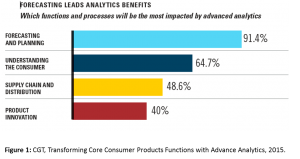 The digital revolution has affected all aspects of business, including supply chains. The Internet of Things (IoT), with its network of devices embedded with sensors is now connecting the consumer to the factory. Technologies such as RFID, GPS, event stream processing (ESP) and analytics are combining to help companies to transform their existing supply chain networks into more flexible, open, agile, and collaborative digital-driven models. Digital supply chains enable business process automation, organizational flexibility, and digital management of corporate assets.
The digital revolution has affected all aspects of business, including supply chains. The Internet of Things (IoT), with its network of devices embedded with sensors is now connecting the consumer to the factory. Technologies such as RFID, GPS, event stream processing (ESP) and analytics are combining to help companies to transform their existing supply chain networks into more flexible, open, agile, and collaborative digital-driven models. Digital supply chains enable business process automation, organizational flexibility, and digital management of corporate assets.
Crossing the ‘Digital Divide” requires a holistic approach to digital transformation of the supply chain that includes new skills and corporate behaviors. New capabilities are also required such as digitally connected processes, predictive analytics to sense demand using pattern recognition, and scalable technologies with the capability to process “Big” data using in-memory processing.
What does all this mean?
The gradual replacement of human judgment across the supply chain. Companies will use advanced analytics to optimize complex cross-functional trade-offs to facilitate value across the supply chain directly from the consumer back to the supplier. This new digital supply chain network allows companies to match the long-tail of demand, supply and production capabilities to create the ultimate customer/consumer fit and fulfillment.
Crossing the digital divide will affect all supply chain IT systems. This includes seamless integration across companies, as well as real-time synchronization of data, global standardization of work flows, and rising demands of cybersecurity. This requires companies to evolve in order to best support areas such as automated data gathering, tactical demand planning, procurement, and execution.
The challenges inherent in digital transformation
- Continual connectivity. We live in an always-on, always available world where customers/consumers expect to access information and execute any task from any device.
- Organizational speed. Those companies who recognize market change and opportunities will profit the most from digital transformation.
- Deluge of information. Information is being collected by companies from multiple channels, devices, and forms at tremendous speeds with minimal latency.
Those companies who understand how to capture, store, and process this information will uncover business value and experience the most benefits.
Digital transformation crosses many facets of a company’s business, requiring collaboration platforms, collaborative economy services, and e-commerce. Companies also need to recognize and embrace the emergence of cloud, mobile, social, big data and most of all predictive analytics. Digital transformation hinges on big data and predictive analytics. The predictive analytics process needs to be tied to distinct digital architecture that include data integration and management, robust visualization and statistical models for discovery and prediction, and continuous delivery of insights as events unfold is vital to digital transformation.
According to a recent Consumer Goods Technology report over 90% of companies feel that demand forecasting and planning using the integration of big data and predicative analytics provide the most impact and benefits. This includes both consumer as well as supply chain forecasting and planning.
The myriad of forces impacting the relationship between demand and supply are set to expand their influence as a result of the "automated consumer engagement". The ability to collect real-time consumer demand through digital devices will force companies to digitize their supply chains. Finding ways to be better prepared means implementing a corporate culture and structure that brings together organizations, and most of all, data from different sources. The analytics and technology capability is now available, so organizational changes and skills must transition to the next generation demand management. However, it also requires ongoing change management to not only gain adoption, but to sustain the new corporate culture.
There is a more fluid distribution of goods today because customer purchase behavior has changed the way products are created and sold. The rise of omni-channel and new purchasing processes such as Amazon.com make inventory management more unpredictable. The influence of external factors like social media, twitter, and mobile devices make it more challenging for distributors and retailers to plan deliveries and stock orders. Regardless, next day, or even same day delivery is an expectation that manufacturers and the supply chain process are tasked to provide. These factors are making demand more volatile, and as a result manufacturers can no longer operate using inventory buffer stock to protect against demand volatility as it can too easily result in lost profit.
Automated consumer engagement
The definition of ‘fast’ for consumers today is dramatically different to the ‘fast’ of five-ten years ago. Consumers are demanding more, and expect it quicker than ever before. This is being driven by the millennials as they want instant response and same day delivery. Consumer demand is no longer driven by supply availability. A supply push strategy is no longer viably in today’s digital world. Companies must shift their operational models by listening to demand and responding to consumer pull in order to remain successful.
Sales and marketing tactics have to be more focused on the automated consumer engagement. The influence of unstructured data and social media are having a more prevalent impact than ever before on the entire purchase process, which must be factored into the demand management process. This is the result of the openness and availability of consumer feedback that social media influences and delivers. Feedback via social media is both an asset and a liability for retailers, distributors and manufacturers. Although, it provides insight into sentiment and provides opportunity for brand exposure, it adds additional complexity to how consumer pull can be influenced. It also means demand can be influenced across multiple channels and more often than not, with very immediate consequences.
Demand is also changing because customers want to consume products in new ways. Subscription lifestyles and shared economies due to the on-demand world have impacted how companies need to plan, design, and create products for an indecisive generation of consumers. The consumer experience must remain at the forefront of retailer and manufacturer priorities. Flexibility, efficiency and a consumer-centric approach is the key to their success.
Crossing the digital divide requires a complete assessment of current processes, leading to a detailed road-map to move from current state to future state. The focus must be on investment in training people to improve their analytical skills and changing corporate behaviors to sense demand, understand the signals that matter and act on the insights. This is a fundamental shift that is required to maintain a leading edge in the new digitized world we live. As a result, the birth of digital forecasting will emerge that will be more anticipatory, rather than prescriptive.

